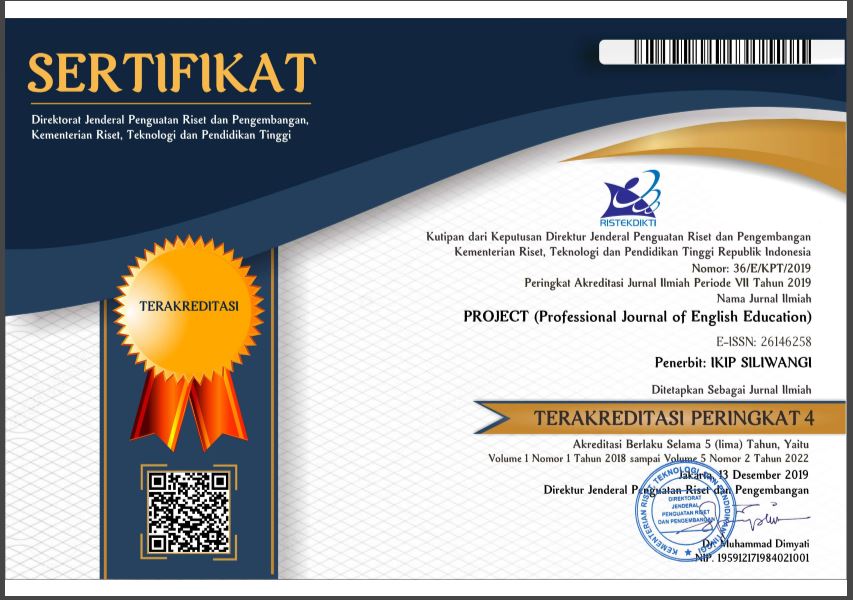The Use of Picture Dictionary to Enhance Students’ Vocabulary Mastery at UPTD SMPN 11 Barru
Abstrak
This study examines how effectively junior high school students vocabulary proficiency may be enhanced using pictorial dictionaries. Classroom Action Research was used in this research, and carried out in two cycles with phases for planning, action, observation, and reflection. Twenty-five pupils from SMPN 11 Barru's class VIII.3 took part, and pre- and post-tests were used to gather data. Only 32% of students received the minimum passing score, according to the pre-test data. After implementing picture dictionaries in Cycle I, 40% met the standard, demonstrating initial progress. Cycle II involved refining the teaching approach, leading to a significant improvement, with 100% of students meeting the minimum standard and the average score rising from 66.6 to 80. The findings highlight the potential of picture dictionaries in fostering vocabulary retention and engagement by providing visual and contextualized learning experiences. These results support the integration of picture dictionaries into vocabulary instruction as a practical and effective tool. Future research could explore the use of digital and augmented reality picture dictionaries to enhance learning outcomes further and address limitations related to abstract concepts.
Referensi
Ain, R. Q., Nawir, A. R., Putra, A. M. U., Ardiana, A & Suwarni, S. (2023). Pictionary Game: Its Effect to Upgrade ESP Students' Vocabulary Mastery at SMK Negeri 2 Pangkep. Eltin Journal: Journal of English Language Teaching in Indonesia, 11(1), 31-38. https://doi.org/10.22460/eltin.v11i1.p31-38.
Alhatmi, S. (2019). A Survey Study of the Dictionary Use Sub-strategies of English Majors in Saudi Arabia: Dictionary Related Aspects. English Language Teaching, 12(3), 139. https://doi.org/10.5539/elt.v12n3p139
Anggraeni, R. N., Ngafif, A., & Chasanah, Z. (2021). The Effectiveness of Using Visual Dictionary to Teach Vocabulary at the Grade Students. Scripta : English Department Journal, 8(2), 11–19. https://doi.org/10.37729/scripta.v8i2.1196
Avendano, S. C., & Angulo-Jiménez, H. (2023). Thematic picture dictionaries and other visual resources for Costa Rican indigenous languages: Beyond bilingual equivalencies. Dictionaries: Journal of the Dictionary Society of North America, 44(2), 239-258. doi: https://doi.org/10.1353/dic.2023.a915073
Binhomran, K., & Altalhab, S. (2021). The impact of implementing augmented reality to enhance the vocabulary of young EFL learners. The JALT CALL Journal, 17(1), 23-44. 1 doi: https://doi.org/10.29140/jaltcall.v17n1.304
Bounadjat, A., Belhis, N., & Boukrika, A. (2022). Vocabulary Recall and Retention: A Comparison between the Translation Method and the Pictorial Method in Teaching Vocabulary for Elementary Levels. Université de Jijel. http://dspace.univ-jijel.dz:8080/xmlui/handle/123456789/11467
Dziemianko, A. (2022). The usefulness of graphic illustrations in online dictionaries. ReCALL, 34(2), 218–234. https://doi.org/10.1017/S0958344021000264
Gaspersz, S., & Uktolseja, L. J. (2020). The Use of Serial Picture Media to Improve English Speaking Ability at SMP YPK Syaloom Klademak Sorong City. INTERACTION: Jurnal Pendidikan Bahasa, 7(2), 36. 147–154. https://doi.org/10.1016/j.jnc.2020.125798
Goga, N., Iversen, S. H., Teigland, A.-S., & Iversen, S. H. (2021). The (re)presentation of knowledge about gender in children’s picture dictionaries. Verbal and visual strategies in nonfiction picturebooks, pp. 67–79. https://doi.org/10.18261/9788215042459-2021-06
Hestiana, M., & Anita, A. (2022). The role of movie subtitles to improve students' vocabulary. Journal of English Language Teaching and Learning (JELTL), 3(1), 1715. doi: https://doi.org/10.33365/jeltl.v3i1.1715
Kara, S., & Kucuk, T. (2023). The Effects of Picture Dictionaries in Promoting Vocabulary Development of EFL Learners at Tertiary Level. Novitas-ROYAL (Research on Youth and Language), 17(2), 80–94
Kurniawan, A., Susilohadi, G., & Sulistyawati, H. (2018). Improving students' vocabulary mastery using picture dictionary. Universitas Sebelas Maret.
Meesuk, P., Sramoon, B., & Wongrugsa, A. (2020). Classroom Action Research-based Instruction: The Sustainable Teacher Professional Development Strategy. Journal of Teacher Education for Sustainability, 22(1), 98-110. doi:10.2478/jtes-2020-0008
Othman, M. S., Hosshan, H., Mohd Jamil, M. R., Arun, Y., Bahuruddin Setambah, M. A., Mohamad Hanapi, M. H., Shuib, T. R., Mohamad Hashim, A. T., & Md Zalli, M. M. (2022). Picture-vocab: Self-made picture dictionary to improve pupils’ vocabulary retention in Malaysia. International Journal of Evaluation and Research in Education (IJERE), 11(4), 2192–2199. doi: 10.11591/ijere.v11i4.23077
Panjaitan, E. R., Lutfiyanti, W., & Sinaga, I. M. (2024). The influence of vocabulary mastery and reading strategy on students’ reading ability. Wiralodra English Journal, 8(1), 259. doi: https://doi.org/10.31943/wej.v8i1.259
Pateşan, M., Balagiu, A., & Alibec, C. (2018). Visual aids in language education. International conference Knowledge-based Organization, 24(2) 356–361. https://doi.org/10.1515/kbo-2018-0115
Putri, E. (2022). An impact of the use Instagram application towards students vocabulary. Jurnal Pustaka Ilmu, 2(2), 1-10.
Putri, Z. M., & Wahyuni, E. (2019). Vocabulary learning strategy employed by high-achiever university students at Malang. A Journal of Culture, English Language Teaching, Literature and Linguistics, 6(1), 78–89.
Roessingh, H. (2020). Culturally Responsive Pedagogy and Academic Vocabulary Teaching and Learning: An Integrated Approach in the Elementary Classroom. TESL Canada Journal, 37(1), 51–62. https://doi.org/10.18806/tesl.v37i1.1334)
Suniyasih, N. M., Ratminingsih, N. M., & Budasi, I. G. (2020). Development of Multilingual Thematic Picture Dictionary: A Support For Literacy. Jurnal Pendidikan dan Pengajaran, 53(3), 236-243. 1 https://dx.doi.org/10.23887/jpp.v53i1.27508
Wazeema, T. M. F., & Kareema, M. I. F. (2017). Implication of multimedia audio-visual aids in the English language classroom. The 7th International Symposium of South Eastern University of Sri Lanka (SEUSL). https://www.seu.ac.lk/researchandpublications/symposium/7th/Inaternational%2 0Symposium%202017%20-%20SEUSL%20(39).pdf
Zhou, K., Jin, F., Li, W., Song, Z., Huang, X., & Lin, C.-H. (2024). The design of technology-enhanced vocabulary learning: A systematic review. Education and Information Technologies, 29, 14875–14897.





